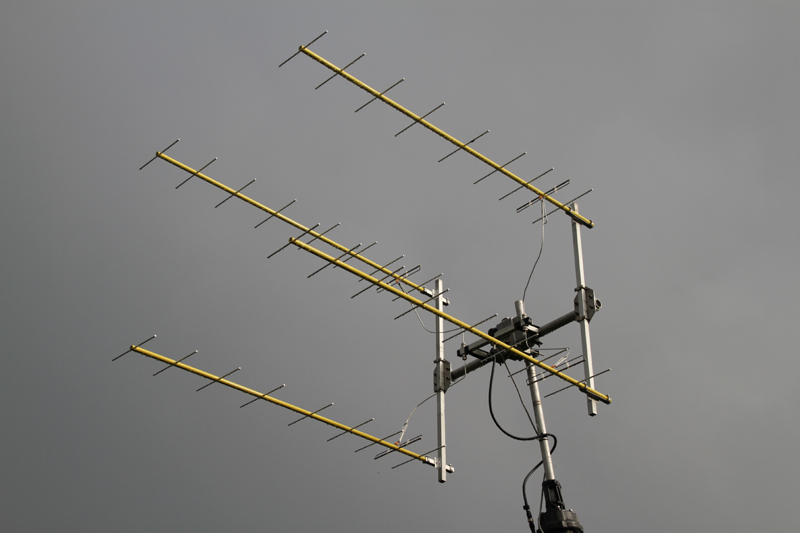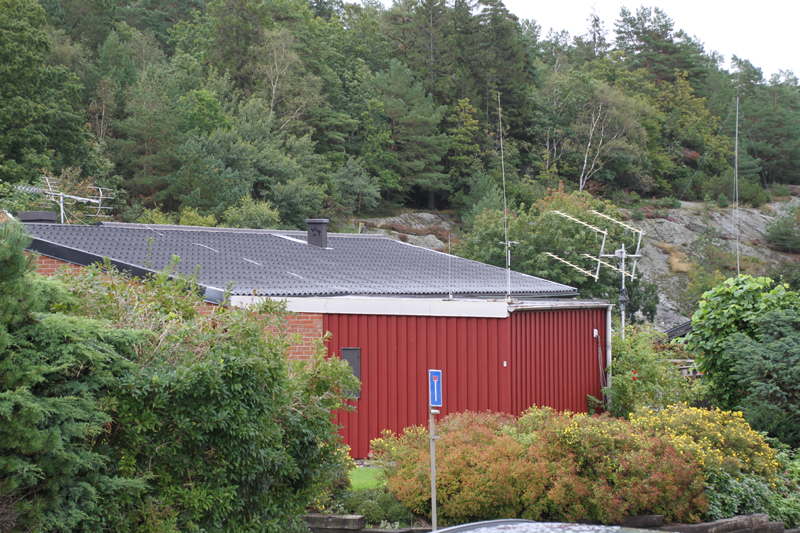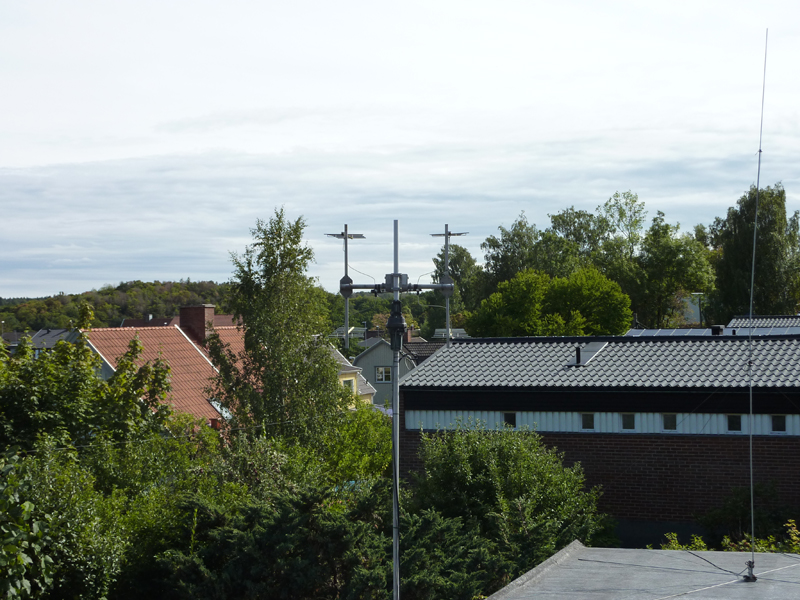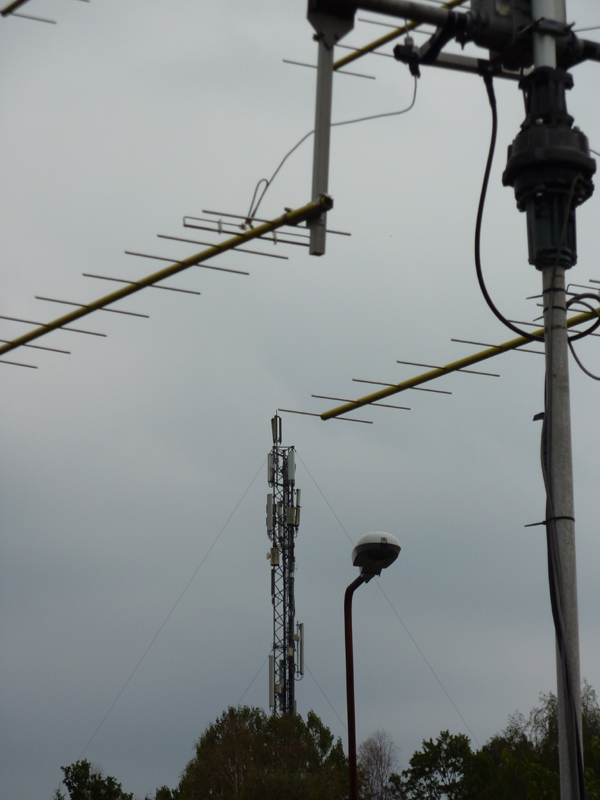
SM6FHZ 432 MHz Meteor Scatter
Patience and persistence is the mother of 70cm meteor scatter!
I have just recently started working 432 MHz meteor scatter from JO67AQ. My first QSO was made during Quadrantides 2018. From Perseids 2019 I work 432 MHz meteor scatter from my EME QTH in JO57XJ as well.
Rig
Today (from summer of 2016) I am using a 4x9 el yagi array fully steerable in azimuth and elevation. The rig is an IC-706Mk2G driving a SSPA with an BLF184XR. The yagi array is depicted below as well as an description of the yagi and array design in an pdf-document. The IC-706Mk2G is injection locked to a 10 MHz oven reference for good frequency accuracy and stability. I can use either FSK441 or JTMS from a ASUS GL552VW computer via a home made interface circuit. For the moment I prefer FSK441 as I have not had too much luck using JTMS.

432 MHz 4x9el yagi array description
The rig in JO57XJ is my EME rig consisting of my 5.5m dish and a GS23B PA.My
present QTH in JO67AQ is unfortunately on the south side of a hill and
only 100
m from the steep southern slope of that hill. This means that I am
shielded from signals from about 270 degrees azimuth over north and to
about 80 degrees azimuth. I need to elevate the array at least 20
degrees to clear the peak of the hill. I will be limited in working
meteor scatter in those directions as I need to use the elevation to
beam
above the obstructions.
 In this picture the array is elevated 20
degrees in
an azimuth of 40 degrees.
In this picture the array is elevated 20
degrees in
an azimuth of 40 degrees. My
present take off in direction south. Antennas are slightly
elevated.
My
present take off in direction south. Antennas are slightly
elevated.
The
RF-environment is quite harsh with a lot of noise and spurious signal
sources all around me. This is very annoying.
A
well loaded tower of a cellular site just 150 m from my antenna in SSW
direction. Good filtering is needed in front of the LNA. Fortunately, I
do not think there is any 450 MHz system in this tower.

It
is however fun to see what can be done in 70cm meteor scatter with
these limitations and a moderate station in an suburban location.
Meteor scatter features I have experienced on 432 MHz
The
meteor scatter signals on
432 MHz show some features compared to lower bands. There
are still a lot of exciting things to learn about meteor scatter on 432
MHz. I
would appreciate to get your feedback and you to share your experience
on the 432 MHz meteor scatter features.
Direction
You
can chose between
direct path, Hot A or Hot B. I have not yet seen any favorites here.
I do not use Hot A or Hot B on greater distances (>1100-1200 km).
Choosing a time when the radiant is in a good position seems to help a
lot. Perpendicular to the path and not too high or too low in the
sky. Too high radiant seems to be worse than a very low radiant, as
long as the radiant is above the horizon.
Doppler
I have not yet seen too much of Doppler shift on meteor scatter signals on 432 MHz, as I am aware of. Maybe some of the frequency off-sets I have seen on sked partners could be attributed to Doppler shift. It does not seem to be happening on every burst nor ping. During Perseids 2019 I got some bursts with a clear Doppler distortion. These bursts did not decode.
Burst
from F6DRO received during a sked i Perseids 2019. You can see the
clear Doppler distortion on the burst. The sound when receiving this
burst had a clear Doppler sound to it.
Meteor showers
So
far I have only
experience from Quadrantides, Lyrids, eta-Aquariids, Perseides, Leonids, Ursids and Geminids of 2018
in meteor scatter signals
on
432 MHz. What I have noticed, is that you need to be close to the peak
of the shower to have a decent chance to complete a QSO. Persistence
and perseverance is what is needed. Dedication does help as well. Do
not settle for less than a 2
hour sked, you may need more than that. Only Quadrantids, Persides and Geminids
have produced any completed QSO's. Lyrids, eta-Aquariids, Ursids
and Leonids produced
some reflections but no QSO's. It looks like a good rule to use the
major showers with good meteor count and avoid the smaller showers to
have as good as possible success rate. However, some of the minor
showers are known to have outbursts (meteor storms) now and then, e.g.
Orionids, Leonids and Ursids. Keep track of any predictions for such at
the IMO web site.
Planning
There are a few parameters that are good to grasp when planning for meteor scatter skeds on 432 MHz.
You can follow this procedure and use these tools for planning your 432 MHz Meteor Scatter skeds and work. There may be different opinions on some of my statements above. Please tell me if you have other experience and recommendations!
Examples
of radiant graphs produced by RadiantCalc below.
I am using RadiantCalc
for prediction of the radiant position for the meteor shower in
question for the year in question. RadiantCalc is written in Matlab, but
is compiled to an standalone application where you need have the Matlab Run-time
Environment installed on your computer. The Matlab Run-time Environment
is free and is included in the installation file of RadiantCalc.
RadiantCalc is still being evolved and I have a few more ideas to be
implemented into it.
Handy assets
I use the following web sites to get information about radiant calculations and the probability for meteor scatter propagation on 432 MHz.
International Meteor Organization (IMO) web site with shower lists and data: https://www.imo.net/
Sidereal time calculation on line: http://www.jgiesen.de/astro/astroJS/siderealClock/
Calculations of radiant position from IMO data: http://www.stargazing.net/kepler/altaz.html
Calculation of the time for maximum from Solar longitude (found in the meteor shower table from IMO): http://wise-obs.tau.ac.il/~eran/Wise/Util/SolLon.html
OK1TEH
has a lot of information about 432 MHz meteor scatter at his web page: http://ok1teh.nagano.cz/ms_70cmlog_text.htm
All five contain relevant information.
Results
I
received from G4RGK a 3 seconds burst via meteor scatter on
432 MHz i Perseids 2018.
My
final rogers as received by OK1TEH on 2018-08-12 via 432 MHz MS in a 6
seconds burst i Perseids 2018.
The longest burst received so far is 23 seconds in the QSO with GM0ICF on August 12, 2024. Se below screenshots.
The second half (11.5 seconds) of the same burst as GM0ICF received me for a total burst lenght of 23 seconds.
QSOs
Below is a summary of all 432 MHz meteor scatter QSO's / stations worked by me over time.
| Call | Square | My Loc | Date | Time [UTC] | Mode | Sent RST | Rec. RST | Prop. Mode | Field | DXCC | Distance [km] | QTF [º] | Elevation [º] | SL | IMO SL for peak | Time relative to predicted shower peak | Radiant height [Deg] | QTF to Best dir. off-set [Deg] | Shower | Antenna |
| YU1EV | KN04CN | JO67AQ | 2018-01-04 | 05:30-08:00 | JTMS | 26 | R26 | MS | 1 KN | 1 | 1565 | 155 | 10 | 283.6 | 283.15 | +11h | 73-82 | 50 CCW | Quad | 4x9el |
| OK1TEH | JO70FD | JO67AQ | 2018-08-12 | 07:30-10:00 | FSK441 | 26 | R26 | MS | 2 JO | 2 | 854 | 158 | 10 | 139.35 | 140 | -16h | 65-50 | 45 CCW | Pers | 4x9el |
| G4RGK | IO91ON | JO67AQ | 2018-08-12 | 11:00-13:00 | FSK441 | R37 | 27 | MS | 3 IO | 3 | 1070 | 236 | 3 | 139.5 | 140 | -13h | 45-35 | 10 CW | Pers | 4x9el |
| GM8IEM | IO78HF | JO67AQ | 2018-08-12 | 16:30-19:00 | FSK441 | 26 | R26 | MS | 4 | 1026 | 268 | 8 | 139.7 | 140 | -7h | 25-28 | 5 CCW | Pers | 4x9el | |
| UT5DL | KN18EP | JO67AQ | 2018-12-13 | 18:00-18:50 | FSK441 | 26 | R26 | MS | 5 | 1216 | 141 | 8 | 261.4 | 262.2 | -18h | 20-30 | 10 CCW | Gemi | 4x9el | |
| IK0BZY | JN61GW | JO67AQ | 2018-12-14 | 05:00-06:50 | JTMS | 26 | R29 | MS | 4 JN | 6 | 1752 | 179 | 6 | 261.95 | 262.2 | -6h | 42-28 | 10 CCW | Gemi | 4x9el |
| RK2P | KO93AD | JO67AQ | 2018-12-14 | 14:40-16:20 | FSK441 | R26 | 26 | MS | 5 KO | 7 | 1710 | 96 | 6 | 262.3 | 262.2 | +3h | 5-10 | 20 CCW | Gemi | 4x9el |
| OM5CM | JN87WV | JO67AQ | 2018-12-14 | 16:50-18:55 | FSK441 | 26 | R26 | MS | 8 | 1157 | 158 | 10 | 262.45 | 262.2 | +5h | 12-28 | 20 CW | Gemi | 4x9el | |
| LX1DB | JN39CO | JO67AQ | 2018-12-14 | 19:00-20:20 | FSK441 | R26 | 26 | MS | 9 | 946 | 192 | 12 | 262.5 | 262.2 | +8h | 28-40 | 30 CW | Gemi | 4x9el | |
| F6KBF | JN18BW | JO67AQ | 2018-12-14 | 20:30-22:55 | FSK441 | 26 | R27 | MS | 10 | 1172 | 207 | 12 | 262.55 | 262.2 | +9h | 40-58 | 20 CW | Gemi | 4x9el | |
| RK2P | KO93AD | JO57XJ | 2019-08-12 | 16:55-19:35 | FSK441 | 26 | R26 | MS | 1712 | 95 | 3 | 139.45 | 140 | -13h | 25 | 5 CW | Pers | 5.5m dish | ||
| DL8DAU | JO40ME | JO57XJ | 2019-08-12 | 20:30-21:00 | FSK441 | 26 | R26 | MS | 11 | 857 | 194 | 10 | 139.55 | 140 | -10h | 35 | 70 CW | Pers | 5.5m dish | |
| 9A5M | JN95GO | JO57XJ | 2019-08-13 | 02:50-04:35 | FSK441 | 26 | R26 | MS | 12 | 1387 | 158 | 8 | 139.85 | 140 | -4 - -2.5h | 70-75 | 10 CCW | Pers | 5.5m dish | |
| YU1EV | KN04CN | JO57XJ | 2019-08-13 | 05:35-06:25 | FSK441 | 26 | R26 | MS | 1538 | 155 | 4 | 139.95 | 140 | -1.5 - -0.5h | 75-85 | 30 CCW | Pers | 5.5m dish | ||
| F6DRO | JN03TJ | JO57XJ | 2019-08-13 | 07:00-08:45 | FSK441 | R26 | 36 | MS | 1710 | 209 | 5 | 140.05 | 140 | 0 - +1h | 60-70 | 10 CW | Pers | 5.5m dish | ||
| YO2LSP | KN05NR | JO57XJ | 2020-12-13 | 16:00-18:10 | FSK441 | 26 | R26 | MS | 13 | 1442 | 150 | 5 | 261.9 | 262.2 | -9 - -7h | 8-20 | 10 CW | Gemi | 5.5m dish | |
| S51LF | JN75CN | JO57XJ | 2020-12-13 | 18:20-19:20 | FSK441 | 26 | R26 | MS | 14 | 1356 | 173 | 5 | 261.95 | 262.2 | -7 - 6h | 20-30 | 10 CW | Gemi | 5.5m dish | |
| IW4ARD | JN64FD | JO57XJ | 2020-12-13 | 19:50-20:04 | FSK441 | 26 | R26 | MS | 1506 | 179 | 5 | 262.0 | 262.2 | -5h | 35 | 10 CW | Gemi | 5.5m dish | ||
| IU4CHE | JN64GB | JO57XJ | 2020-12-13 | 20:06-20:12 | FSK441 | 26 | R26 | MS | 1483 | 178 | 5 | 262.0 | 262.2 | -5h | 35 | 10 CW | Gemi | 5.5m dish | ||
| IK3VZO | JN55XA | JO57XJ | 2020-12-13 | 20:18-20:41 | FSK441 | R26 | 37 | MS | 1376 | 180 | 5 | 262.0 | 262.2 | -5h | 35-40 | 10 CW | Gemi | 5.5m dish | ||
| YO2NAA | KN05NS | JO57XJ | 2020-12-14 | 07:01-07:08 | FSK441 | R26 | 26 | MS | 1463 | 151 | 5 | 262.45 | 262.2 | +6h | 28 | 50 CCW | Gemi | 5.5m dish | ||
| F2CT | IN93GJ | JO57XJ | 2020-12-14 | 08:00-08:40 | FSK441 | R26 | 26 | MS | 6 IN | 1819 | 217 | 2 | 262.5 | 262.2 | +7h | 20-15 | 10 CW | Gemi | 5.5m dish | |
| F1NZC | JN15MR | JO57XJ | 2020-12-14 | 08:52-10:30 | FSK441 | 26 | R26 | MS | 1434 | 209 | 5 | 262.6 | 262.2 | +8 - +10h | 15-7 | 30 CCW | Gemi | 5.5m dish | ||
| G4YTL | IO92MB | JO57XJ | 2020-12-22 | 06:00-08:23 | FSK441 | R26 | 26 | MS | 1035 | 240 | 8 | 270.6 | 270.7 | -2h | 70 | 30 CCW | Ursids | 5.5m dish | ||
| IK4PMB | JN54MM | JO57XJ | 2021-01-03 | 16:00-16:50 | FSK441 | 26 | R26 | MS | 1433 | 182 | 4 | 283.2 | 283.15 | +2h | 25 | 50 CCW | Quad | 5.5m dish | ||
| RO3X | KO73FU | JO57XJ | 2021-08-12 | 11:00-13:03 | FSK441 | R26 | 26 | MS | 1460 | 114 | 4 | 139.7 | 140 | -7h | 40 | 50 CW | Pers | 5.5m dish | ||
| YO5AVN | KN17WW | JO57XJ | 2021-08-12 | 20:50-22:07 | FSK441 | 26 | R26 | MS | 1321 | 147 | 6 | 140.1 | 140 | +3h | 40 | 10 CW | Pers | 5.5m dish | ||
| OE3JPC | JN88EW | JO57XJ | 2021-12-14 | 07:35-08:05 | FSK441 | 26 | R27 | MS | 15 | 1093 | 162 | 8 | 262.2 | 262 | +4h | 25 | 50 CCW | Gemi | 5.5m dish | |
| G4RGK | IO91ON | JO57XJ | 2021-12-14 | 08:20-08:52 | FSK441 | R37 | 26 | MS | 1046 | 242 | 8 | 262.2 | 262 | +4h | 20 | 30 CW | Gemi | 5.5m dish | ||
| OK2AQ | JN89HF | JO57XJ | 2022-12-14 | 06:00-06:35 | FSK441 | 26 | R26 | MS | 960 | 159 | 8 | 261.9 | 262 | -1h | 30 | 20 CCW | Gemi | 5.5m dish | ||
| S51ZO | JN86DR | JO57XJ | 2023-08-12 | 19:00-20:30 | FSK441 | R26 | 26 | MS | 1252 | 164 | 7 | 139.5 | 140 | -12h | 30 | 45 CW | Pers | 5.5m dish | ||
| GM0ICF | IO75PP | JO57XJ | 2024-08-12 | 10:55-12:32 | FSK441 | R27 | 27 | MS | 1038 | 266 | 8 | 139.9 | 140 | -1h | 45 | 26 CCW | Pers | 5.5m dish | ||
| GM0ICF | IO75PP | JO57XJ | 2024-12-13 | 16:00-18:03 | FSK441 | 26 | R26 | MS | 1038 | 266 | 8 | 261.8 | 262.2 | -8h | 15 | 50CCW | Gemi | 5.5m dish | ||
| HA1FV | JN87JJ | JO57XJ | 2025-01-03 | 14:00 - 16:00 | FSK441 | 26 | R26 | MS | 16 | 1160 | 162 | 6 | 283.15 | 283.15 | At peak | 30 | 55CCW | Quad | 5.5m dish |

Updated January 4, 2025. http://www.2ingandlin.se/SM6FHZ.htm